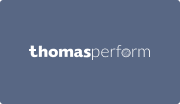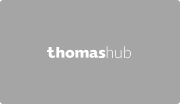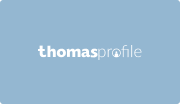It’s that time again when we all look back over the past year and use what’s gone before to make predictions on what’s to come. 2020 is going to be a tough act to follow and forecasts this time round are tricky!
Data from this year is skewed and full of anomalies, workplaces and team dynamics have transformed overnight, global trading partnerships are being renegotiated and we’re still in the midst of a global pandemic. But we’ve got our finger on the pulse at Thomas and are boldly sharing the trends and developments that we think will be paramount over the coming months.
1. A whole new level of flexibility in how, and where, we work
We like to think that we’ve had flexible working in place for some time, but 2020 has brought this to a whole new level. This trend is here to stay, and 2021 will see increased variations in acceptable schedules, locations and methods. This is a progressive step forward – perhaps the greatest shakeup in office working for decades – that should be embraced and supported.
There’s a balance to be achieved, though, between enabling employees to work outside of standard office hours, and expecting them to. Many companies have reported that remote working has increased productivity while workers have been using early mornings and evenings to work, leaving periods in the daytime free for childcare or recreation.
However, we’ve identified three areas which may cause issues within the workforce: The challenge of always being “on”; pressure from remote presenteeism and the fear of being thought of as slacking; and the general myth of quantity over quality.
To address these, we recommend putting guidance in place to cement some parameters and build essential trust:
- Create routines – flexibility is fine, but some semblance of routine helps staff to know when and how to stay in contact with each other.
- Account for individual personality traits – understanding your workforce’s levels of motivation and adaptability, and preferred communication styles will allow better flexible management.
- Provide regular feedback and ensure team members connect often, even if this means having a child or dog in the background (or foreground!) of your Zoom call.
We have a wealth of further advice around the subjects of employee engagement, flexible working, resilience and wellbeing on our resources web page. Importantly, businesses must be proactive and lead changes towards better working practices so they are well placed to accommodate continued requests for changes to the normal work schedule, as employee demands will continue to evolve. In turn, this will keep their current employees engaged and present an attractive opportunity to prospective candidates.
2. The approaching wave of recruitment activity - an opportunity and a risk
While recruitment in some sectors such as financial services, healthcare and tech have remained buoyant, most areas have seen a sharp downturn over the past 9 months. Graduates have been particularly hard hit, seeing the largest fall in the UK since the 2008 financial crisis in a drop of 12% this year [1].
However, we believe things are about to change and envisage a massive upturn in hiring during the first half of 2021. Recruiters and HR specialists will already be finding themselves inundated with applicants for every vacancy, and this will only continue, especially as many roles can now be filled by remote workers, reducing the need to recruit locally.
While there will still inevitably be high unemployment through 2021, most sectors will experience growth and look to rebuild their teams. Companies embracing more flexible attitudes to standard working hours and locations will see the greatest recovery.
So that’s a good thing, right? Well, yes, growth has to be a positive, and offers shiny new opportunities to increase productivity and financial viability, which should be grabbed and maximised. But there’s also risk. Companies must prepare now if they’re to be correctly positioned to be able to identify top talent from more candidates than ever.
It’s also imperative to select the right candidate first time and fast to ensure they have a team and operating capability to take advantage of the upturn in economy that's coming – act slowly or ineffectively and your competitors will outflank you.
3. Predictive hiring becomes mainstream: data becomes imperative to position insight over impulse
It’s important to be able to predict who will be productive and engaged in certain roles and working environments; predicting goodness of fit makes good business sense, but also plays a part in improving individual wellbeing, which in turns leads to increased productivity. As the increase in relative candidates-to-roles ratio becomes apparent, it will become harder to predict who will deliver productivity and drive your business.
How can recruiting companies be sure of finding the best talent from this unusually large pool? This challenge will see an increased use of predictive hiring tools – platforms that predict success by measuring aptitudes, personality traits and other characteristics, providing comparable data.
These are designed to help reduce the cost-per-hire, decrease the time-to-hire, and improve the effectiveness of teams by more accurately identifying best-fit candidates for critical roles. This assists recruiters to reduce costs whilst improving productivity, since best-fit candidates generally have a longer tenure, both in their initial jobs and within the enterprise longer term. This can, in turn, reduce direct onboarding and replacement costs, decrease new hire training costs, and speed their time to competency.
However, to maintain the integrity of your organisation, you must consider the ethical aspect to this data collection. Just because you can compile all this information, doesn’t necessarily mean that you should.
It’s vital to ensure that data you collect is being used fairly and in a way that’ s socially responsible, and that any data processing is managed and overseen by your Data Officer. There’s lots more information about data protection and processing on the Information Commissioner’s Office website (ICO) – check through to make sure you’re being responsible and legally compliant.
4. Increasing automation will enable more progressive HR
Dealing with this upturn will be made simpler and faster through an accelerated adoption of HR tech, for example, employee payroll and compensation software, workforce analytics and applicant tracking systems (ATS). There’s already a huge amount of automated assistance available, but expect to see new offerings come quickly to market.
This wave of automation will be adopted by agile mid-market organisations and SMBs too, not just large enterprises, so don’t think you’re too small for this to matter to you. Industry-wide adoption of this tech needs to be actioned quickly but with minimum disruption to current business operations – HR Tech should sit alongside and support your processes, not look to replace them overnight.
We advise caution in selecting which tools to invest in as new users will need effective support and guidance, especially if they haven’t used such software before. We’ve published informative guides to help with selecting the right talent assessment provider for your business and knowing when to use a talent assessment platform.
5. A strategic focus on addressing the skills gap
Many businesses are facing reorganisation and significant operating change going into the New Year. It’s going be vital that companies remain agile and able to deploy skills across the business when and where needed. Management must find ways to ensure their staff are receptive to changed duties, roles and priorities.
As companies look at what it will take to digitalize their operations, many HR leaders see there is a significant skills gap. In fact, 64% of managers don't think their employees are able to keep pace with future skill needs. Furthermore, 70% of employees say they haven't even mastered the skills they need for their jobs today.
Gartner, Bridging the Skills Gap
Gartner’s finding above provides more questions than answers. If employees are struggling to build the right skill set, what are managers doing to support them?
These are areas where psychometric assessments add great value. Understanding what motivates employees, where their inherent skills lie and how they communicate with others will enable businesses to identify those staff who can be developed and effectively retrained to fill gaps within the organisation. Or indeed, to identify limitations and therefore introduce development programmes for staff to better meet the demands of their current roles.
A study by Oxford Economics in 2012 stated that 41% of participant companies had recently completed a significant transformation initiative or are currently undergoing one, while another 47% of those surveyed are preparing to do so [2].
The report goes on to identify 4 key areas which are likely to require redeployment of skills to address shortages: digital skills, global operating skills, agile thinking, and interpersonal and communication skills. We see these areas as still highly relevant today. Alongside these, companies will do well to recognise how other traits are valued in the workplace – what was a strength in the “old world” may be positioned as a limitation in the “new” one.
How can HR managers navigate this challenge? After all, the buck usually stops with them when it comes to delivering a robust learning and development programme. Redeploying staff will require additional training and support, and there’s unlikely to be any extra money to be spared from already tight budgets.
Employees will recognise that a flood in talent on the market means each new role will be harder to acquire, so internal development will look appealing. They will expect employers to invest both cash and resource in this area, so offering a strong L&D plan will be attractive for your staff and potential candidates. Using psychometric testing enables HR managers to identify the exact areas in which an employee needs to strengthen or grow, and can support targeted, lean development plans.
Another option to address skills shortages within a business is the use of temporary or contract staff. This is often seen as a solution because securing temporary resources requires less recruiting, onboarding and long-term costs and can be turned around more quickly.
A KMPG and Recruitment and Employment Confederation (REC) report, published in December 2020, reported that the permanent placements index was 48.2 while the temporary billings index was 56.1 [3] – showing decline in permanent positions and growth in temporary ones. Don’t think that this is the golden bullet for meeting resource requirements though – it’s still essential to be sure that you’re hiring the right temporary skills and traits just as much as when you look longer term.
Correctly managing these change processes could make the difference between a successful 2021 and a disastrous one. Our comprehensive Guide to Change Management provides further advice and assistance on how to successfully navigate change programmes without disengaging staff.
6. Hybrid workforce, blended teams will be the language of 2021
In June this year, PwC conducted a survey in the US which confirmed that 69% of financial services firms expect to have at least 60% of their workforce working from home at least once a week in the future, a massive shift from 29% before the Covid-19 pandemic [4]. We suspect that this figure would be even higher if the survey was carried out now, 6 months down the line. In the same month, Adecco reported that 77% of UK workers want to see a mix of office-based and remote working post Covid-19 [5].
Remote working is not only more acceptable than ever, it’s been encouraged and even enforced for many. While some have embraced working at home, others have missed the bustle of the office, and 2021 will see a further separation between these views as many workers will find themselves with the choice of where to work from. A hybrid team – a workforce which is a true mix of remote and onsite working – is emerging and will increase through next year. The first organisations to get plans in place to support this will ultimately be the most successful.
At Thomas, we see hybrid working practices as a powerful force for increased productivity, inclusion and for expanding the reach of talent you can achieve. Working parents (especially working mothers who suffer the greatest ‘family planning’ penalty to their careers) will be more able to contribute on a level playing field, and location may no longer be an influential factor in moving jobs. Mid-market companies that have traditionally struggled to recruit because of low population density will find their talent pool expanding massively if they can support flexible working.
Each day at your workplace could look very different, with part of your team coming into the office some days, whilst others stay at home. So how do you manage a hybrid workforce and ensure that you’re still including those who are not necessarily there in person? Which roles are best suited to remote working and which will benefit from face-to-face interaction? Companies will need to find new ways to ensure cohesion across teams and may need to formalise these in a company policy outlining what options are acceptable and when.
Wellbeing needs to be front-of-mind in planning. Deloitte estimated the cost of poor mental health in the workplace to be around £45m in 2019, an increase of 16% on the previous year6, and this seems likely to rise. We know how closely linked wellbeing and employee engagement are, and the welfare of the workforce matters greatly. Team building events are often easier in person, but virtual quizzes, online games and happy hours can help bring an online social aspect to remote working. More introverted members of the team may actually prefer this approach to the traditional activities, where they may have struggled to fit in or be listened to.
Our whitepaper, Remote Working: Personality and Performance Research Results gives insights on the correlations between personality and performance with remote working, and further tips on the subject are on our resources webpage.
Why should you listen to us?
We’ve been leaders in the recruitment solutions sector for nearly 40 years, and our tools are grounded in proven science and continuously validated.
Our talent assessment platform has been helping organisations of all types around the world transform their performance through smarter people decisions, looking beyond just skills and experience to recruit better and build successful teams.
We’re constantly in touch with industry leaders and influencers as well as those involved with day-to-day HR operations. While we don’t have a crystal ball, we believe we’ve got a pretty good idea about what’s going on in recruitment right now, and what influences are at play for the future.
Our manifesto has been compiled with these uncertainties in mind to offer practical advice and clear guidance on smart recruitment, managing disengaged staff and challenging high-performing employees. It offers guidance for a tough and changeable business environment to help you unleash the power of your people.
Sources:
- https://www.theguardian.com/money/2020/nov/11/graduate-recruitment-suffers-biggest-uk-fall-since-2008-crisis
- https://www.oxfordeconomics.com/Media/Default/Thought%20Leadership/global-talent-2021.pdf
- https://www.rec.uk.com/our-view/reports-jobs
- https://www.pwc.com/us/en/industries/financial-services/library/balancing-remote-and-in-office-work.html
- https://adeccogroup.co.uk/news/uk-workforce-wants-hybrid-working/



